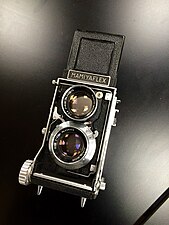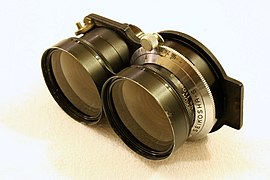
A single-lens reflex camera (SLR) is a camera that typically uses a mirror and prism system that permits the photographer to view through the lens and see exactly what will be captured. With twin lens reflex and rangefinder cameras, the viewed image could be significantly different from the final image. When the shutter button is pressed on most SLRs, the mirror flips out of the light path, allowing light to pass through to the light receptor and the image to be captured.

A twin-lens reflex camera (TLR) is a type of camera with two objective lenses of the same focal length. One of the lenses is the photographic objective or "taking lens", while the other is used for the viewfinder system, which is usually viewed from above at waist level.

Mamiya Digital Imaging Co., Ltd. is a Japanese company that manufactures high-end cameras and other related photographic and optical equipment. With headquarters in Tokyo, it has two manufacturing plants and a workforce of over 200 people. The company was founded in May 1940 by camera designer Seiichi Mamiya and financial backer Tsunejiro Sugawara.
Omega is the brand name of several medium-format cameras that were initially developed and sold by Simmon Brothers starting from 1954, then licensed to and manufactured by Konica and then Mamiya from 1964 until 1981, when the line was discontinued.

Rollei was a German manufacturer of optical instruments founded in 1920 by Paul Franke and Reinhold Heidecke in Braunschweig, Lower Saxony, and maker of the Rolleiflex and Rolleicord series of cameras. Later products included specialty and nostalgic type films for the photo hobbyist market.
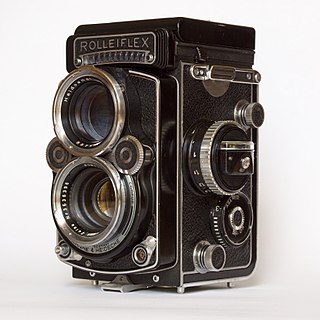
Rolleiflex is the name of a long-running and diverse line of high-end cameras originally made by the German company Franke & Heidecke, and later Rollei-Werke.

The Argus C3 was a low-priced rangefinder camera mass-produced from 1939 to 1966 by Argus in Ann Arbor, Michigan, United States. The camera sold over 2.2 million units, making it one of the most popular American cameras in history. Due to its shape, size, and weight, it is commonly referred to as "The Brick" by photographers. The most famous 20th-century photographer who used it was Tony Vaccaro, who employed this model during World War II.

The Rollei 35 is a 35mm miniature viewfinder camera built by Rollei. The original Rollei 35, when introduced at photokina in 1966, was the smallest existing 135 film camera. The Rollei 35 series remains one of the smallest 35 mm cameras after the Minox 35 and Minolta TC-1. In 30 years, about 2 million Rollei 35 series cameras were manufactured. The Rollei 35 was manufactured by DHW Fototechnik up to 2015, the successor of Franke & Heidecke as small-batch production. The last version is the Rollei 35 Classic, an updated Rollei 35 SE.

The Mamiya C330 Professional is a traditional film twin-lens reflex camera introduced in the 1970s for the professional and advanced amateur photography markets. This model was 340 grams lighter than the previous model C33, which weighed 2040 grams. The later C330f is an improvement on the C330 and was succeeded by the C330S with further improvements.
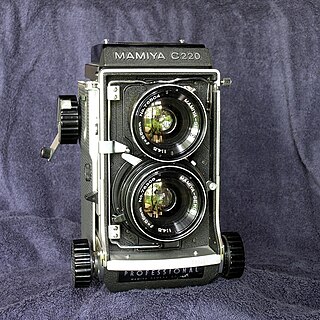
The Mamiya C220 is a lightweight twin-lens reflex camera made in the early 1970s by the Japanese camera manufacturer Mamiya. The camera has interchangeable lenses ranging from 55 mm wide-angle to 250 mm telephoto and accepts 120 and 220 rollfilms. The rack and pinion focusing system with a bellows makes it possible for close-up photography without attachments. The straight film path has no sharp turns for absolute flatness of the film.

The Nikkorex nameplate was used for a series of 35 mm film, single-lens reflex cameras sold by Japanese optical manufacturer Nippon Kogaku K.K., as well as a series movie cameras and movie projectors. The models, made by other companies, were designed and marketed as low-cost, feature-reduced equipment for the consumer market.

The Mamiya RZ67 is a professional medium format single-lens reflex camera manufactured by Mamiya. There are three successive models: the RZ67 Professional, RZ67 Professional II and RZ67 Professional IID. It is primarily designed for studio use, but can also be used in the field.

The Contaflex series is a family of 35mm Single-lens reflex cameras (SLR) equipped with a leaf shutter, produced by Zeiss Ikon in the 1950s and 1960s. The name was first used by Zeiss Ikon in 1935 for a 35mm Twin-lens reflex camera, the Contaflex TLR; for the earlier TLR, the -flex suffix referred to the integral reflex mirror for the viewfinder. The first SLR models, the Contaflex I and II have fixed lenses, while the later models have interchangeable lenses; eventually the Contaflexes became a camera system with a wide variety of accessories.

The Auto-Reflex and Autoreflex is a series of 35mm SLR cameras made by Konica from 1965 to 1988. All these models have the Konica AR bayonet.

Contarex is a line of 35mm single lens reflex cameras (SLRs) made by Zeiss Ikon. It was first presented at Photokina in 1958 and initially scheduled for delivery in the spring of 1959, but it was not made generally available in the United States until March 1960. The first model is popularly known as the Contarex I, the Bullseye, or the Cyclops, after the prominent light meter window above the lens, in front of the pentaprism. The camera was aimed at the high-end and professional markets; in 1961, the retail price was $499.

The Mamiya Press is a line of medium-format rangefinder system press cameras manufactured by Mamiya. The first model was introduced in 1960, and the final model was discontinued in the 1970s. It was targeted at the professional press photography market, and a wide array of accessories was offered.
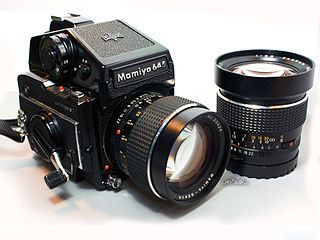
The Mamiya 645 camera systems are a series of medium format film and digital cameras and lenses manufactured by Mamiya and its successors. They are called "645" because they use the nominal 6 cm x 4.5 cm film size from 120 roll film. They came in three major generations: first-generation manual-focus film cameras, second-generation manual-focus film cameras, and autofocus film/digital cameras.

The Mamiya RB67 is a professional medium format single-lens reflex system camera manufactured by Mamiya. There are three successive models: the RB67 Professional, RB67 Pro-S and RB67 Pro-SD. It is primarily designed for studio use, but can also be used in the field.

The Vito and Vitomatic, Vitoret, and Vito Automatic were several related lines of 35 mm compact viewfinder and rangefinder cameras made by Voigtländer from the 1940s through the early 1970s, equipped with leaf shutters, similar in concept to and marketed against the competing Kodak Retina cameras manufactured by Kodak. All of these cameras were fixed-lens models; the models in the Vito line identified with Roman numerals were equipped with folding mechanisms and collapsible lenses for portability, while the others were rigid, non-folding cameras.

